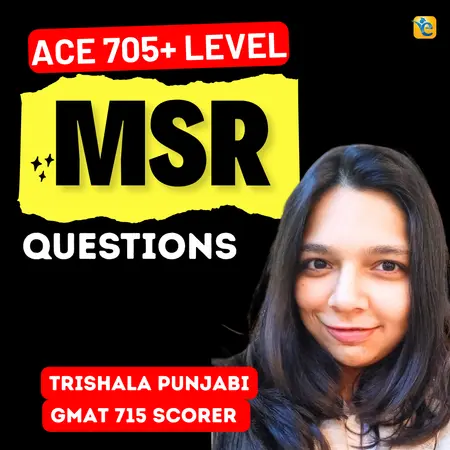Events & Promotions
|
|

GMAT Club Daily Prep
Thank you for using the timer - this advanced tool can estimate your performance and suggest more practice questions. We have subscribed you to Daily Prep Questions via email.
Customized
for You
Track
Your Progress
Practice
Pays
Not interested in getting valuable practice questions and articles delivered to your email? No problem, unsubscribe here.
- Nov 19
12:30 PM EST
-01:30 PM EST
Learn how Keshav, a Chartered Accountant, scored an impressive 705 on GMAT in just 30 days with GMATWhiz's expert guidance. In this video, he shares preparation tips and strategies that worked for him, including the mock, time management, and more - Nov 18
11:00 AM PST
-12:00 PM PST
Join us in a live GMAT practice session and solve 30 challenging GMAT questions with other test takers in timed conditions, covering GMAT Quant, Data Sufficiency, Data Insights, Reading Comprehension, and Critical Reasoning questions. - Nov 20
01:30 PM EST
-02:30 PM IST
Learn how Kamakshi achieved a GMAT 675 with an impressive 96th %ile in Data Insights. Discover the unique methods and exam strategies that helped her excel in DI along with other sections for a balanced and high score. - Nov 22
11:00 AM IST
-01:00 PM IST
Do RC/MSR passages scare you? e-GMAT is conducting a masterclass to help you learn – Learn effective reading strategies Tackle difficult RC & MSR with confidence Excel in timed test environment - Nov 23
11:00 AM IST
-01:00 PM IST
Attend this free GMAT Algebra Webinar and learn how to master the most challenging Inequalities and Absolute Value problems with ease. - Nov 24
07:00 PM PST
-08:00 PM PST
Full-length FE mock with insightful analytics, weakness diagnosis, and video explanations! - Nov 25
10:00 AM EST
-11:00 AM EST
Prefer video-based learning? The Target Test Prep OnDemand course is a one-of-a-kind video masterclass featuring 400 hours of lecture-style teaching by Scott Woodbury-Stewart, founder of Target Test Prep and one of the most accomplished GMAT instructors.
A
Be sure to select an answer first to save it in the Error Log before revealing the correct answer (OA)!
Difficulty:
 55%
(hard)
55%
(hard)
Question Stats:
47% (01:03) correct 53%
(01:17)
wrong
53%
(01:17)
wrong  based on 12968
sessions
based on 12968
sessions
History
Date
Time
Result
Not Attempted Yet
Scientists have recently discovered what could be the largest and oldest living organism on Earth, a giant fungus that is an interwoven filigree of mushrooms and rootlike tentacles spawned by a single fertilized spore some 10,000 years ago and extending for more than 30 acres in the soil of a Michigan forest.
(A) extending
(B) extends
(C) extended
(D) it extended
(E) is extending
(A) extending
(B) extends
(C) extended
(D) it extended
(E) is extending
Show Spoilernytimes article
https://www.nytimes.com/1992/04/02/us/twin-crowns-for-30-acre-fungus-world-s-biggest-oldest-organism.html
The organism is a giant fungus, an interwoven filagree of mushrooms and rootlike tentacles spawned by a single fertilized spore 1,500 to 10,000 years ago and now extending for more than 30 acres in the soil of a forest near Crystal Falls, Mich., along the Wisconsin border.
Why is extending and spawned parallel participial phrases?
The organism is a giant fungus, an interwoven filagree of mushrooms and rootlike tentacles spawned by a single fertilized spore 1,500 to 10,000 years ago and now extending for more than 30 acres in the soil of a forest near Crystal Falls, Mich., along the Wisconsin border.
Why is extending and spawned parallel participial phrases?
Kudos
Bookmarks
A is the correct answer. This question is about the use of present vs past participle.
present participle is used to denote a present condition that still prevails
past participle is used to denote a completed action, usually in a passive mood
The sentence is definitely talking about the filigree:
filigree [of mushrooms and rootlike tentacles] spawned by a single fertilized spore some 10,000 years ago and extending for more than 30 acres in the soil of a Michigan forest
What is b/w brackets is a prepositional phrase and remove it to make the sentence less cumbersome:
filigree spawned by a single fertilized spore some 10,000 years ago and extending for more than 30 acres in the soil of a Michigan forest
As you can see, the filigree spawned by X some 10,000 years ago. This warrants the use of past participle. Also, "spawned by" denotes passive voice which justifies the use of past participle.
As for the "extending", it is still prevailing today in the Michigan forest so you cannot use past participle "extended".
The present and past participles are used to describe the "filigree", they act as adjectives.
present participle is used to denote a present condition that still prevails
past participle is used to denote a completed action, usually in a passive mood
The sentence is definitely talking about the filigree:
filigree [of mushrooms and rootlike tentacles] spawned by a single fertilized spore some 10,000 years ago and extending for more than 30 acres in the soil of a Michigan forest
What is b/w brackets is a prepositional phrase and remove it to make the sentence less cumbersome:
filigree spawned by a single fertilized spore some 10,000 years ago and extending for more than 30 acres in the soil of a Michigan forest
As you can see, the filigree spawned by X some 10,000 years ago. This warrants the use of past participle. Also, "spawned by" denotes passive voice which justifies the use of past participle.
As for the "extending", it is still prevailing today in the Michigan forest so you cannot use past participle "extended".
The present and past participles are used to describe the "filigree", they act as adjectives.
balajinaik
Hi,
Scientists have recently discovered what could be the largest and oldest living organism on Earth, a giant fungus that is an interwoven filigree of mushrooms and rootlike tentacles spawned by a single fertilized spore some 10,000 years ago and extending for more than 30 acres in the soil of a Michigan forest.
It is imperative to understand the meaning of the sentence in order to get the correct answer. So let’s do that first. Scientists have recently discovered something that could be the largest and oldest organism on Earth. So what have they discovered? They have a discovered a giant fungus which has qualities that make the scientists believe that this fungus could be the largest and oldest living organism. What are these qualities? This giant fungus is an interwoven filigree of mushrooms and rootlike tentacles. This fungus has been spawned by a single fertilized spore some 10,000 years ago. So this is why the scientists think that this fungus is the oldest living organism. The other quality that the fungus has is that it extends for more than 30 acres. This is the reason why the scientists think this fungus to be the largest living organism


After we have understood the meaning, let us evaluate the errors in the sentence. Now notice “spawned” is not verb here. It is verb-ed modifier that is presenting the quality of the giant fungus. In the very same way, “extending” is a verb-ing modifier that is also presenting another quality of the fungus. Hence, verb-ed modifier “spawned” and the verb-ing modifier “extending” are parallel to each other. Hence this sentence is correct as it is.
POE:
Choice A: extending: Correct.
Choice B: extends: Incorrect. This is a verb and a verb cannot be parallel to a modifier.
Choice C: extended: Incorrect. We again have a verb in the past tense that cannot be parallel to a modifier. Also the fungus is still extending. It is still there. So use of past tense is wrong anyway.
Choice D: it extended: Incorrect. Same error as in Choice D.
Choice E: is extending: Incorrect. This is a verb and a verb cannot be parallel to a modifier.
Hope this helps to understand why choice A is the correct answer.
Thanks
Shraddha

















